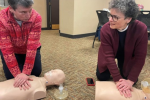July 13, 2012
Viability and Vitality
What is unique to congregational vitality and how is it different from congregational viability in the ways that intersect with mission?
Congregational vitality has risen to its appropriate place of prominence in The Episcopal Church through the prophetic work of Stephanie Spellers with her book, Radical Welcome, Tom Brackett's emphasis on church planting and many other creative Episcopalians. The Episcopal Church has the gift of Bob Honeychurch, a wonderful missioner for congregational vitality. Many dioceses also have congregational vitality officers or congregational vitality is one area of responsibility for a member of the bishop's diocesan staff.
There is an abundance of lists of vitality characteristics that assist congregations in making their own self-assessment that might lead to new commitments or mission initiatives. Among these lists I particularly recommend to readers, the list included in Born of Water, Born of Spirit: Supporting The Ministry of the Baptized in Small Congregations by Sheryl A. Kujawa-Holbrook and Fredrica Harris Thompsett.
The Diocese of Massachusetts defines congregational vitality as "the congregation's lively response to God's mission." There are many congregations who suffer from viability challenges that are also vital congregations. I have met people from these vital congregations that are threatened by viability challenges although they are alive with their response to God's mission. Some vital congregations do close because they were not viable. Congregations threatened with viability challenges may experience issues with "the stability and strength of a congregation's finances, property and administrative functions".
Vitality and viability both address mission, but in different ways. Congregational vitality strengthens mission. Sometimes an impediment to mission is a viability issue for a congregation. Often the building impedes a congregation's mission. With an early and courageous enough congregational response it is possible to think about mission differently. Yet effective congregational responses are often delayed in one of two ways. Congregations get stuck in their discernment process when they seek either less death or they deny death. In both cases congregations forfeit an opportunity to ask where life is even at the end of their mission in one place and in one familiar form.
Congregations freely choose to be vital.
Vital congregations don't always have the freedom or the resources to be viable.
It is possible for a vital congregation to close in a celebratory way that prepares for new forms of vitality and life. When congregations conflate vitality and viability they postpone creative congregational responses and diminish their potential for bold mission. When congregations decouple vitality and viability, while holding each lightly, then they are able to ask where they might find more life in viable ways. The difference is always to let go and choose life. When a congregation is vital and viable then mission flourishes in new forms.





